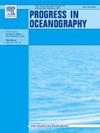Drivers of growth and decay of Sargassum in the Tropical Atlantic: A Lagrangian approach
IF 3.8
3区 地球科学
Q1 OCEANOGRAPHY
引用次数: 0
Abstract
The proliferation of Sargassum in the Tropical Atlantic has occurred almost every year since 2011, but a strong variability of biomass is observed among years. Essential knowledge about the drivers of Sargassum growth and decay is still lacking to explain this interannual variability. Benefiting from accurate basin scale Sargassum detections provided by remote sensing, and from physical and biogeochemical ocean simulations, we developed a Lagrangian drift-growth model to simulate Sargassum distribution over the period 2016–2020. The resulting trajectories and biomass time series of Sargassum aggregates were analyzed to highlight the main limiting factors of growth and decay. The nitrogen and phosphorous concentrations are found to be weakly restrictive compared to physical limiting factors, especially the temperature. In particular, the warm waters found off northern Brazil appear to be instrumental in triggering the end of seasonal growth of Sargassum. The timing of the seasonal warming of this region strongly impacts the quantities of Sargassum simulated each year. This suggests that this region should be monitored to anticipate the development of Sargassum and resulting strandings.
热带大西洋马尾藻生长和腐烂的驱动因素:拉格朗日方法
自 2011 年以来,马尾藻在热带大西洋几乎每年都会大量繁殖,但生物量的年际变化很大。有关马尾藻生长和腐烂驱动因素的基本知识仍然缺乏,无法解释这种年际变化。得益于遥感提供的精确的海盆尺度马尾藻探测结果以及物理和生物地球化学海洋模拟,我们开发了拉格朗日漂流生长模型,模拟马尾藻在 2016-2020 年期间的分布情况。我们分析了马尾藻聚集体的生长轨迹和生物量时间序列,以突出生长和衰减的主要限制因素。与物理限制因素(尤其是温度)相比,氮和磷浓度的限制作用较弱。特别是,在巴西北部近海发现的温暖水域似乎有助于触发马尾藻季节性生长的结束。该地区季节性变暖的时间对每年模拟的马尾藻数量有很大影响。这表明,应该对这一地区进行监测,以预测马尾藻的生长和由此造成的搁浅。
本文章由计算机程序翻译,如有差异,请以英文原文为准。
求助全文
约1分钟内获得全文
求助全文
来源期刊

Progress in Oceanography
地学-海洋学
CiteScore
7.20
自引率
4.90%
发文量
138
审稿时长
3 months
期刊介绍:
Progress in Oceanography publishes the longer, more comprehensive papers that most oceanographers feel are necessary, on occasion, to do justice to their work. Contributions are generally either a review of an aspect of oceanography or a treatise on an expanding oceanographic subject. The articles cover the entire spectrum of disciplines within the science of oceanography. Occasionally volumes are devoted to collections of papers and conference proceedings of exceptional interest. Essential reading for all oceanographers.
 求助内容:
求助内容: 应助结果提醒方式:
应助结果提醒方式:


